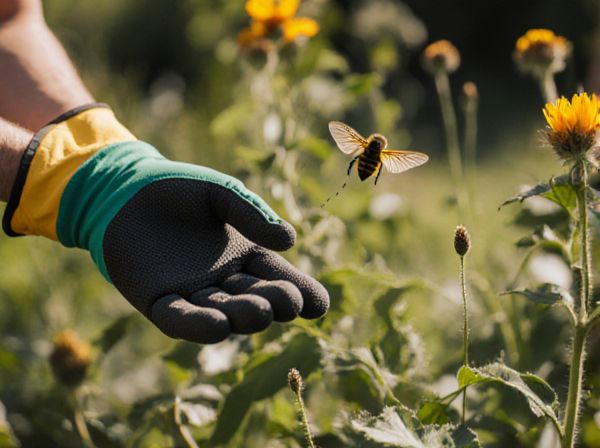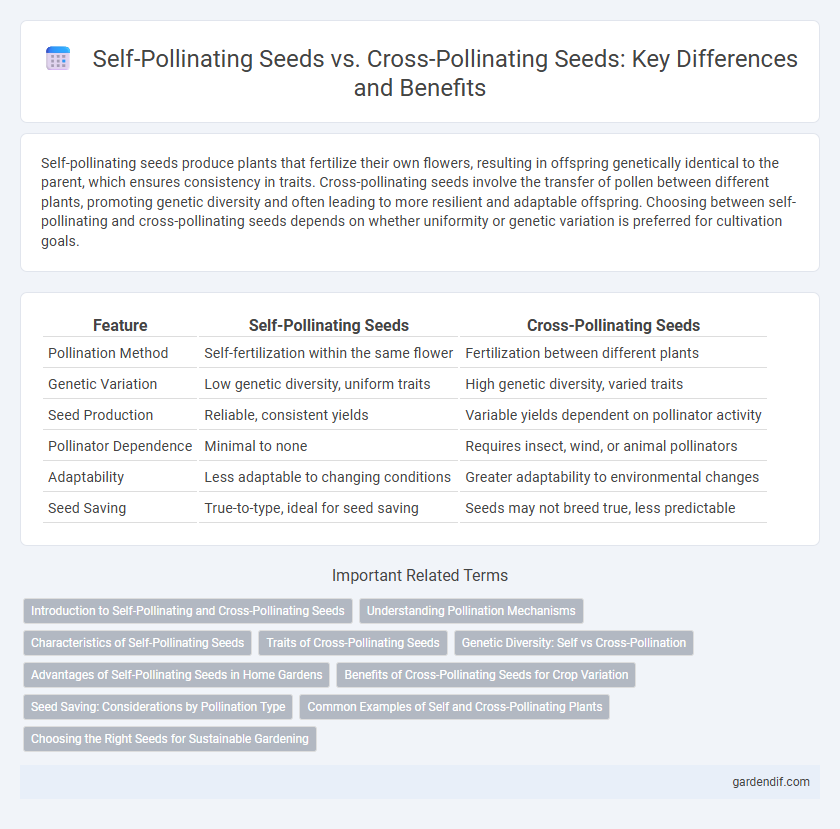
Self-pollinating seeds vs Cross-pollinating seeds Illustration
Self-pollinating seeds produce plants that fertilize their own flowers, resulting in offspring genetically identical to the parent, which ensures consistency in traits. Cross-pollinating seeds involve the transfer of pollen between different plants, promoting genetic diversity and often leading to more resilient and adaptable offspring. Choosing between self-pollinating and cross-pollinating seeds depends on whether uniformity or genetic variation is preferred for cultivation goals.
Table of Comparison
| Feature | Self-Pollinating Seeds | Cross-Pollinating Seeds |
|---|---|---|
| Pollination Method | Self-fertilization within the same flower | Fertilization between different plants |
| Genetic Variation | Low genetic diversity, uniform traits | High genetic diversity, varied traits |
| Seed Production | Reliable, consistent yields | Variable yields dependent on pollinator activity |
| Pollinator Dependence | Minimal to none | Requires insect, wind, or animal pollinators |
| Adaptability | Less adaptable to changing conditions | Greater adaptability to environmental changes |
| Seed Saving | True-to-type, ideal for seed saving | Seeds may not breed true, less predictable |
Introduction to Self-Pollinating and Cross-Pollinating Seeds
Self-pollinating seeds develop when a plant's flowers fertilize themselves, resulting in offspring genetically similar to the parent, promoting consistency in traits. Cross-pollinating seeds arise from the transfer of pollen between different plants of the same species, enhancing genetic diversity and adaptability. Understanding these mechanisms is crucial for gardeners and farmers aiming to select seeds that best suit their cultivation goals and environmental conditions.
Understanding Pollination Mechanisms
Self-pollinating seeds rely on pollen from the same flower or plant, ensuring genetic consistency and stability in successive generations. Cross-pollinating seeds depend on pollen transfer between different plants, promoting genetic diversity and resilience to environmental changes. Understanding pollination mechanisms is crucial for optimizing seed production and improving crop yields in agricultural practices.
Characteristics of Self-Pollinating Seeds
Self-pollinating seeds contain both male and female reproductive organs within the same flower, allowing them to fertilize themselves without the need for pollen from another plant. These seeds typically produce offspring that are genetically uniform, maintaining stable traits across generations. Self-pollinating plants often exhibit greater resilience in controlled environments and require less space for cultivation compared to cross-pollinating varieties.
Traits of Cross-Pollinating Seeds
Cross-pollinating seeds exhibit greater genetic diversity, leading to enhanced adaptability and resistance to diseases and environmental stresses. These seeds often produce hybrid vigor, resulting in higher yields and improved plant vigor compared to self-pollinating seeds. Cross-pollination promotes broader gene flow, which contributes to the development of new traits and overall crop improvement.
Genetic Diversity: Self vs Cross-Pollination
Self-pollinating seeds produce offspring genetically similar to the parent, resulting in limited genetic diversity but greater trait stability. Cross-pollinating seeds facilitate gene flow between different plants, increasing genetic variation and adaptability within the species. Enhanced genetic diversity from cross-pollination improves disease resistance, environmental stress tolerance, and long-term population resilience.
Advantages of Self-Pollinating Seeds in Home Gardens
Self-pollinating seeds offer the advantage of consistent plant traits, ensuring reliable fruit or flower quality in home gardens. These seeds require less space since they do not depend on pollen from other plants, making them ideal for small garden areas. Home gardeners benefit from their ability to produce fruit independently, reducing the risk of pollination failure and increasing overall crop yield stability.
Benefits of Cross-Pollinating Seeds for Crop Variation
Cross-pollinating seeds promote genetic diversity by combining traits from different parent plants, leading to increased crop resilience and adaptability. This enhanced genetic variation helps crops withstand environmental stresses, pests, and diseases more effectively than self-pollinating varieties. Farmers benefit from higher yields and improved quality through the natural hybrid vigor created by cross-pollination.
Seed Saving: Considerations by Pollination Type
Self-pollinating seeds, such as tomatoes and peas, ensure genetic consistency, making them ideal for saving because offspring closely resemble parent plants. Cross-pollinating seeds like corn and squash require isolation distances or physical barriers to prevent unwanted gene flow and maintain seed purity. Seed save strategies must consider pollination type to preserve desired traits and prevent genetic contamination during storage and future planting.
Common Examples of Self and Cross-Pollinating Plants
Tomato, pea, and bean plants are common examples of self-pollinating seeds, as they typically fertilize themselves, ensuring consistent genetic traits. Corn, squash, and watermelon represent cross-pollinating plants, relying on pollen transfer between different plants to increase genetic diversity. Understanding these examples helps gardeners select seeds based on breeding methods for desired crop traits.
Choosing the Right Seeds for Sustainable Gardening
Self-pollinating seeds produce plants that fertilize themselves, ensuring consistent traits and reliable yields, ideal for small-scale or space-limited gardens. Cross-pollinating seeds encourage genetic diversity by requiring pollen transfer between different plants, which enhances disease resistance and adaptability to changing environments. Selecting the right seeds depends on balancing the need for uniformity with the benefits of biodiversity to support long-term sustainable gardening.
Self-pollinating seeds vs Cross-pollinating seeds Infographic

 gardendif.com
gardendif.com